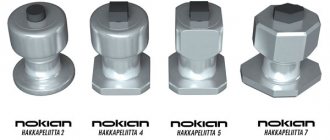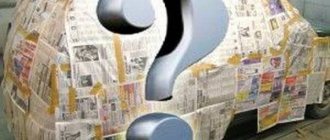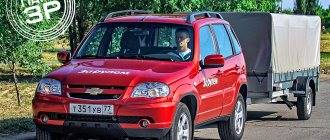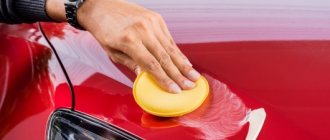Design features
Audi 80 B3 and B4 are theoretically the same car, but with some technical differences. The B4 received a modified platform with a wheelbase increased by 70 mm. The fuel tank was located under the floor, and not as in B3 - behind the sofa. The transformation made it possible to build a station wagon version of the Avant. Previously, only the sedan and coupe were available. It is worth noting that the B3 sedan has a more spacious trunk than the B4 sedan - 453 liters versus 430.
The design of the Audi 80 is very simple, so the car is very reliable. A galvanized body is not prone to corrosion, unless it was hastily repaired in some garage.
Despite the lack of airbags, the car is quite safe. All thanks to the unique Procon-Ten design. In the event of a frontal collision, the engine, through a system of cables, retracts the steering wheel and additionally tightens the seat belts. This significantly reduces the risk of hitting your head on the steering wheel. The steering wheel airbag only appeared in 1993.
The car is front-wheel drive, although it has a longitudinally mounted engine. The suspension design is simple. The front has MacPherson struts and the rear has a torsion beam. The settings provide a high level of comfort and controllability. The ride quality is impressive.
Models were also offered with Quattro all-wheel drive. This is a standard design with a differential and constant distribution of traction along the axles. The system significantly improves traction and handling – the Audi 80 B 4 runs as if on rails. True, the all-wheel drive transmission limits trunk space - the floor is located higher. The Quattro prefix could only be received by modifications with 2.0-2.8 liter gasoline engines.
Safety Audi 80 B4
The safety of the Audi B4 is ensured by the Procon-Ten system, designed to protect the driver in frontal collisions. When risks arise, a special mechanism pulls the steering wheel towards the engine and pulls out the seat belts. The driver gets the opportunity to avoid hitting his head on the steering wheel.
A little later, in 1993, the base model was equipped with airbags in the driver's seat. The passenger seat was equipped with a cushion at the request of the buyer.
The Audi B4 has an effective disc brake system; some models have ABS.
Audi 80 B4 (rear view)
Interior
The interior seems dated today, but back in the 90s it was considered luxurious. Large steering wheel, easy to read gauges, short gear lever, comfortable seats and good workmanship. Wide-opening doors provide convenient access to the interior.
The car was well equipped. But, on the other hand, in the poor versions the equipment was primitive. Today, air conditioning is of greatest importance as the most necessary element in everyday use.
Engines
The range of Audi 80 B4 engines is quite large. The base 1.6-liter gasoline engine developed from 76 to 102 hp. Later, a modernized version of this unit found its way under the hood of the Skoda Octavia and Volkswagen Golf VI.
Much more often, cars with a 2-liter engine 2.0 and 2.0 E came out of showrooms. The engine provided from 90 to 140 hp. (in 16-valve version). In addition, the following were available: a 5-cylinder - 2.3 l (133 hp) and two V6 - 2.6 l / 150 hp. and 2.8 l/174 hp.
Almost all gasoline units were equipped with multipoint injection, mostly electronically controlled. The 5-cylinder has mechanical injection and is therefore completely unsuitable for gas power. Only the basic 1.6 and 2.0 liter versions are equipped with simple single-point injection.
An absolute new addition to the lineup is the 1.9 TDI diesel engine, which replaces the outdated 1.6 TD. The modern design with direct fuel injection made its debut in the Audi 80 B4. The turbodiesel developed 90 hp. and became famous for its durability and efficiency. At the same time, a 75-horsepower diesel engine of the same volume, marked TD, was offered. He is a typical draft horse and does not deserve attention.
Competitors and analogues
When purchasing, many car owners compare the Audi 80 with Russian-made cars, usually VAZ, due to the fact that they are in approximately the same price niche. Cars produced in Russia are noticeably inferior to Audi in terms of workmanship, reliability and safety, although they may even be superior in certain parameters. For example, the ground clearance of our cars is more adapted to Russian roads.
- Lada Priora. On the secondary market, Priora is more expensive; it has a more powerful, but smaller engine. It accelerates faster, consumes less fuel, but is inferior to Audi in terms of fuel tank volume and trunk size. The price for used cars is from 60 to 200 thousand.
- Lada 2109. It has a weaker engine, a smaller tank volume, but is superior in weight. Audi consumes less fuel, accelerates faster, and has a spacious trunk. Price – from 60 to 120 thousand.
- Lada 2112. It has a more powerful engine, accelerates faster, and consumes less fuel. Cost – from 60 to 200 thousand.
- Lada 2110. Consumes less fuel, has a larger trunk volume, but is inferior in engine volume, tank volume and acceleration time. Price – from 40 to 200 thousand.
Read also Review of Audi 8 D3 characteristics and interior design
There are analogues among foreign cars.
- BMW E30. It coincides with Audi in many respects, but the body of the Audi B4 is stronger and not susceptible to corrosion. It looks more modern and younger, and its maintenance is much cheaper. Cost - from 50 to 400 thousand.
- Mercedes 190 – W201. Also susceptible to corrosion if active protection measures are not taken. It has a high-quality finish that does not lose its properties even after years. The equipment is weaker than that of the Audi, the seats are not very comfortable. Price – from 70 to 550 rubles.
- Audi 80 B3. Not much different from the Audi 80 V4. They are the same in many respects, but the B4 is a more advanced model. Price – from 60 to 400 thousand.
Red Audi 80 B4
Which engine to choose?
The market is dominated by models with a 2-liter gasoline engine, available in three versions. The 90-horsepower engine has single-point injection and a simple design. The 2.0 E version was equipped with multipoint injection and developed 115 hp. The top 16-valve variation had a return of 140 hp.
The weakest option is recommended for those who do not care about dynamics. Average fuel consumption will be 8-10 l/100 km. The 16-valve unit, although it does not cause many problems, is more expensive to repair. But it has better dynamic characteristics - 9.6 seconds to 100 km/h. But it consumes more than 12 liters.
The optimal choice is 2.0 E (115 hp). This unit was even used in the successor to the Audi A4 B5. He calmly tolerates the introduction of gas equipment. Any malfunctions are solely due to negligence. Minor defects concern the ignition system and intake system - leaks in the section between the flow meter and the manifold.
Oil leaks are a common occurrence.
At the same time, due to age, any element of the attached equipment may fail, oil leaks occur (from under the valve covers and seals), and rust attacks the exhaust system.
All owner reviews about the Audi 80 B3
Good day, friends and comrades! It’s been a long time since I’ve been tormented by my conscience to share my joy about owning this fiery cart, which I had the opportunity to drive as my first vehicle from the “shaking in the knees” stage to the “hey, kettle, let the tank pass!” stage)
There was never a car in the family. My father once saved up for a Lada, but a strange thing happened, and this money was only enough for a Cossack, which did not suit him at all, and guided by the combat rule “all or nothing” and the samurai code of honor “Bushido” we ended up with a “bus” and before” and “bus and after”, that is, I had to enjoy it exclusively from public transport, so to speak, the old-fashioned way. I never regret it - it’s hard to overestimate its social significance, strengthening the masses, strengthening the nerves, and often, by the will of fate, you find yourself in the company of wonderful, cheerful girls, or just good ordinary people, which is no less pleasant! And it’s cool when you go home after work with a light head and a sense of accomplishment, in anticipation of relaxation and surrounded by the same people, we have good people - people joke, laugh - the working day is over. Damn nice!
However, the thought of owning a personal car never left me - not that it bothered me and interfered with my life (I was one of those guys who, from childhood, preferred weapons over cars), but somehow the need began to manifest itself, especially after that , as a wife, for unknown reasons, developed an active dislike for buses, because... she felt bad in them, and her father did not stop repeating the need to start auto life, because... work, family, prospects, etc. As a result, we bought a newspaper with advertisements and began to think. There was little money (how I was indignant at the “stupid” questions on the forums in the style of “what car should I buy for 7-8 thousand bucks?” - oh, you impudent person, you have so much money and still get screwed!) - he was a naive person... There was a pressing question: what buy a car for 3 thousand American money. I tuned in to the five-door Golf-2, because... from the passenger’s experience, he knew that it was bigger inside than outside, and a taxi driver I knew said that the car was reliable and nothing more was needed. However, another friend of mine strongly persuaded me in favor of the Audi-80, better known in the partisan underground as the “barrel”. He said that it was his first car and that it was a full-fledged car, not like the cramped Golf-2. The head of the security service of our organization also dissuaded us from golf in favor of the “barrel”. In total, there were as many as 2 options that suited me: “barrel” and golf-2, and the Passat is in reserve.
What else breaks?
Given the age, any element of the equipment may fail, but there are no characteristic sore spots.
The owner can afford to travel on bad roads. The suspension is designed in such a way that major repairs do not seem too expensive. Front wishbones made of steel (from 1,500 rubles) have replaceable ball joints (from 400 rubles). Some people note that the lever bushings are not very durable. The rear axle is so primitive that, in principle, there is nothing to break there.
In general, the braking system is very effective, and many examples were equipped with ABS. Trouble can be caused by the parking brake, which often turns sour. Its mechanism requires preventive inspection and cleaning.
Failures also occur in the operation of electrical equipment: lighting systems, electric windows or central locking.
Quite often, the fluid supply tubes to the windshield washer nozzles become disconnected.
Reworking the 2114 engine - reasons and difficulties
Generally speaking, replacing the motor is an undesirable procedure. The reason lies in the fact that the engine installed at the factory is the most optimal for this particular car - everything has already been thought out by the designers and engineers. True, the results obtained do not always satisfy motorists.
So, it’s worth comparing at least the total resource of domestic and foreign engines. For the first (specifically for the VAZ 2114) it is 250,000 kilometers, and for the second (similar in all other parameters) - 500,000 kilometers. Even this fact alone makes drivers think about installing an engine from a foreign car in a VAZ 2114.
Engine dismantling process
Of course, the best option would be to replace the engine in a fully equipped workshop, but if this is not possible (and you really want to do tuning), then you should have the following minimum set of equipment:
- winch, hoist or hydraulic lift;
- shoes;
- jacks;
- cart;
- knob with a set of heads;
- spanners;
- screwdrivers.
Dismantling is carried out in the following order:
- The car is stopped using a hand brake and shoes, which should be placed under the rear wheels.
- Place the front wheels on jacks.
- With the hood open, disconnect the “mass” terminal and all small hoses and tubes suitable for the engine.
- Seal the pipe inlets to the engine to prevent them from clogging.
- Disconnect the throttle cable from the throttle pipe and bracket.
- Disconnect the air intake hose together with its bracket.
- To dismantle the air filter - to do this, use a sharp blade to cut off the three rubberized supports, due to which it is attached to the engine body.
- Remove the hoses leading to the receiver.
- Disconnect the hose intended for purging the adsorber from the nozzle.
- Remove the wires suitable for the pipe, the ignition module, as well as all others connected to the internal combustion engine.
- Remove the engine splash guard by unscrewing the mounting bolts.
- Drain all the coolant by removing the plugs on the cylinder block and radiator (while opening the reservoir cap).
- Drain the oil by unscrewing the plug cap on the gearbox.
- Disconnect the clutch cable.
- Secure the hooks of the lifting device to the eye bolts located on the gearbox and on the cylinder block, and then remove the engine.
Installation of the new motor is carried out in exactly the same order, but in reverse order. Also, it is important not to forget to connect the wires of all sensors to the correct connectors and refill all technical fluids that were drained during dismantling (coolant and oil).
Despite the fact that some car enthusiasts advise first removing the gearbox and then removing the engine, it is strongly recommended to remove the engine together with the gearbox.
Exterior and interior
Those who take a sedan think little about the size of the trunk. The volume here is very average. But you need to understand that such a car is not intended to carry a refrigerator, but for transportation.
The suspension of the Audi A80 is a regular beam. In the 90s they already made cars with all-wheel drive on a multi-link system! In the Russian Federation and the USSR, alas, one should not count on this.
A careful review of the Audi 80 shows that despite the fact that the car is old, the body was already galvanized in those years. Take the same new Ford Focus, and it will have a lot of problems and shortcomings right from the factory. And this legendary car is still running and in good condition.
If you look at the central panel, it immediately becomes clear that the car was made by engineers, and not like now by marketers who are chasing appearance and beauty. Here everything is thought out to the smallest detail, from the build quality to the materials. And at this moment you feel like you are sitting in a German state. The instrument panel neither creaks nor squeaks, although it is made of high-quality plastic. You sit in it and there is no disgust, despite the fact that the car is from 1992. On the central panel the usual ones were spinning. The Audi A6 will already have buttons.
Of course, it’s better for you to choose what to take: a used foreign car, but a little newer, or a proven one, but a little older.
Of course, there will be little space in the rear seats; a tall person’s knees will rest, but if you are of average height, then you will be quite comfortable.
Which imported engine should you prefer?
Now let's move on to the main question - what engine can be installed on the VAZ 2114? Answering this question, I would like to remind you once again - you should choose only the one that can be installed without modifications or with a minimum number of them.
These imported engines include engines from:
- AUDI-80;
- BYD F3;
- Alfa Romeo;
- Chery Amulet;
- Chevrolet Aveo;
- Ford Focus;
- Fiat Bravo;
- Geely CK2;
- Geely MK1;
- Honda Civic;
- Daewoo Lanos;
- Opel Astra;
- Hyundai Accent;
- Opel Corsa;
- Opel Astra Kadett;
- Opel Astra Vectra B;
- Seat Ibiza;
- Mazda 323;
- Mazda 626;
- Peugeot 205;
- Peugeot 405;
- Toyota Supra;
- Renault Logan;
- Volkswagen Golf;
- Volkswagen Jetta.
All of the listed engines can be installed on the 14th VAZ with a minimum of alterations to other mechanisms, in most cases - without any alterations at all. This will help save not only effort and money for additional work on replacing units, but can also save a lot of nerves when registering a car with the road inspection (although registering such a tuned car will still be a very big problem).
That is why, before deciding which engine is suitable for a VAZ 2114 from a foreign car, it is better to think again about tuning an existing, original engine. There are quite a few ways to increase its power and service life without replacing it with another, and all of them are completely legal from the point of view of the law.
Advantages and disadvantages
According to reviews, the Audi 80 B3 is still the standard of quality and reliability. Many people note minor shortcomings, mainly due to low-quality spare parts. The car holds the road well, is easy to drive, and has good sound insulation. Easy to start even in cold weather.
Read also 2020 Audi R8 review: a dream car
Other benefits:
- reliability;
- body strength, absence of corrosion even on a 30-year-old car;
- excellent cross-country ability, maneuverability;
- adaptability to different roads and any weather conditions.
Audi 80 B3 in profile
The interior finishing is also not satisfactory, the seats are very comfortable, although a little cramped in the back, the instrument panel is beautiful, made of soft plastic that does not deteriorate or fade over time.
Audi 80 B3 rarely breaks down, factory parts and spare parts are of excellent quality. At the same time, it has high maintainability, it is easy to fix everything even on your own. Domestic car owners easily adapted spare parts from other cars to it,
The weak point is the suspension, which is not quite suitable for our roads. The carburetor is also weak and requires periodic replacement or adjustment. The shape of the trunk is inconvenient: it is extended deep and has a narrow lid. Headlights do not always illuminate well at night.
This video will help you find out the problems and advantages of the Audi 80 B3:
What to choose: AUDI 80 B3 or VW Passat B3?
AUDI 80 B3 and VW Passat B3 are two of the most popular and best-selling cars at the Grodno Car Market.
We compared the 1988 VW Passat B3 with a 1.8 petrol engine (carburetor) and the 1988 AUDI 80 B3 with a similar engine.
The class of these cars is the same. The price of AUDI is on average 200 cu higher. As of March 2007, the price of AUDI is about 3000 euros, and VW is 2850 euros. (88 year, 1.8 gasoline). None of the cars have additional options. And even such familiar things as power steering or central locking are very rare.
Options and modifications
The Audi B3 was sold all over the world under the branding Audi 80 and Audi 90. Since 1988, they began to produce a new two-door Audi Coupe (Tour 89), which was developed on the basis of the B3 sedan. Its wheelbase has been shortened slightly and the rear body has been modified.
Since 1989, the car was equipped with a body of the new Tour 8A model, which outwardly was almost no different from the previous one. Structural updates were made, and the suspension underwent noticeable changes. In the same year, the Audi 90 quattro and Audi Coupe quattro began production for the North American market. These were luxury models with more powerful, improved engines.
Read also: Nuances of servicing the Audi A4 B8 after restyling with reviews
Manufacturers installed many options for different power plants on their cars. Let's consider the list of gasoline modifications of engines with manual transmission.
Audi 80 B3 in red
Front wheel drive:
- 1.6 l MT 75, 70 l. With.
- 1.8 l S MT 88, 113, 75 l. With.
- 1.8 l E MT 112 l. With.
- 2.0 l E MT 113 l. With.
- 2.0 l MT 160.137 (115.113) l. With.
All-wheel drive petrol:
- 1.8 MT 113 l. With.
- 1.8 MT 88, 90 l. With.
- 2.0 E MT 137 l. With.
- 2.0 MT 112 l. With.
Diesel front-wheel drive modifications with manual transmission:
- TD MT 1.6 l, 80 l. With.
- D MT 1.6 l, 54 l. With.
- D MT 1.9 l 68 l. With.
Among Russians, the most popular petrol engines are 1.6 and 1.8 liters (especially 1.8) with a capacity of 90 hp. With.
Audi 80 B3 in blue











